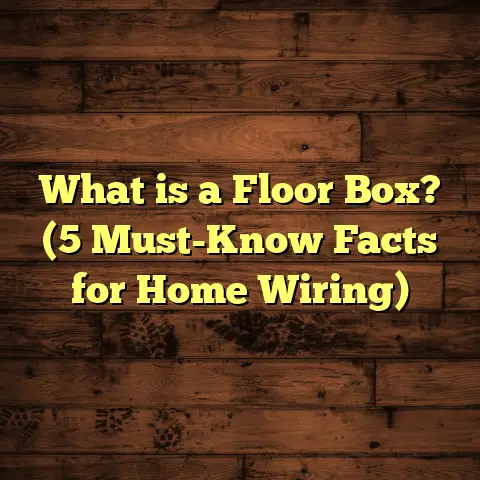What is a Floor Joist Crawl Space? (5 Key Benefits Explained)
There’s something oddly ironic about the very spaces we often ignore in our homes — the crawl spaces beneath our floors. These hidden areas hold a surprising amount of importance, especially when it comes to floor joists. Sometimes, the things we overlook turn out to be the backbone of a solid, comfortable home. So, what exactly is a floor joist crawl space, and why should you care about it? Let me walk you through what I’ve learned from years of hands-on experience and research in flooring and home construction.
What Is a Floor Joist Crawl Space?
Simply put, a floor joist crawl space is the hollow area beneath your floor where the floor joists — the long, horizontal supports that hold up your floor — are exposed and accessible. This space usually exists between your home’s foundation and the bottom of your floor deck. It’s often just tall enough for a person to crawl through (hence the name) and serves multiple purposes beyond just supporting the floor.
Floor joists themselves are critical structural components. They span from wall to wall or beam to beam and bear the weight of everything above — furniture, people, appliances — you name it. The crawl space around these joists allows for ventilation, access for repairs, and routing of utilities like plumbing or electrical wiring.
In older homes or those with raised foundations, this space is more common, while newer constructions might use slab foundations where there’s no crawl space at all. But wherever they exist, these crawl spaces play a key role in the home’s overall health.
Anatomy of Floor Joists and Crawl Spaces
To really get why crawl spaces matter, it helps to understand how joists fit into the home’s structure. Floor joists are typically made of wood (often dimensional lumber like 2x8s or 2x10s), engineered wood products, or steel in some cases. They rest on foundation walls or beams and support the subflooring — plywood or OSB panels — that your finished flooring attaches to.
The crawl space itself varies widely in size. Some are just 18 inches high, barely enough to squeeze through; others can be 3 feet or more in height. The height affects how easy it is to use the space for maintenance or inspections. I’ve seen some crawl spaces so cramped that contractors had to work lying flat on their backs!
Why Floor Joist Crawl Spaces Exist
Historically, crawl spaces were built to:
- Keep floors elevated: This separation protects floors from ground moisture.
- Provide access: For plumbing, wiring, or structural inspections.
- Allow ventilation: To prevent moisture buildup and maintain dry wood.
- Facilitate insulation: Some types of crawl space insulation improve energy efficiency.
Different climate zones and construction styles influence whether homes have crawl spaces or slab foundations. In areas prone to flooding or with expansive soils that shift a lot, crawl spaces help protect the home structure better than slabs.
Why Do Floor Joist Crawl Spaces Matter? Five Benefits I’ve Seen Up Close
1. Improved Air Circulation and Moisture Control
One of the biggest challenges in home building is moisture management. Moisture trapped under your floor can lead to wood rot, mold growth, and even structural damage over time. I’ve come across countless cases where poor ventilation in crawl spaces caused costly repairs later on.
A well-ventilated floor joist crawl space helps air flow beneath your floors, reducing humidity levels and preventing moisture accumulation. This airflow helps keep the wooden joists dry and strong. According to the U.S. Department of Energy, proper crawl space ventilation can reduce moisture problems by up to 50%.
I remember working on a house where the family was dealing with a persistent musty smell and warped floors. Once we installed adequate vents and sealed off water leaks in the crawl space, the problem cleared up quickly, saving them from replacing the entire floor structure.
How Moisture Damages Floor Joists
Moisture attacks wood on several fronts:
- Rot: Wood decays when exposed to consistent dampness.
- Mold: Mold spores thrive in moist environments, creating health hazards.
- Pest attraction: Damp wood attracts termites and carpenter ants.
In one case study I reviewed from a home inspection firm, over 60% of homes with unventilated crawl spaces showed signs of wood rot in floor joists within 10 years of construction. That’s huge when you think about how critical those joists are!
Managing Crawl Space Moisture: Ventilation vs. Encapsulation
Two main approaches help control moisture:
- Ventilation: Installing vents allows outdoor air to circulate under floors.
- Encapsulation: Sealing off the crawl space with vapor barriers and conditioning it like an interior room.
Which method is better depends on your climate. In humid southern states, encapsulation often works best because outdoor air brings in more moisture than it removes. In cooler northern climates, ventilation helps keep humidity low.
I once worked on a project in Florida where encapsulating the crawl space reduced indoor humidity by nearly 15%, improving comfort and protecting flooring materials.
2. Easy Access for Maintenance and Repairs
Have you ever had to tear up your entire floor just to fix a pipe or inspect wiring? That’s a nightmare I’ve helped many clients avoid. Crawl spaces make it much easier to access plumbing, electrical lines, HVAC ducts, and even pest control treatments without major demolition.
When I’m called in for floor repairs or upgrades, having a crawl space means I can inspect and reinforce joists or subflooring efficiently. It also allows me to detect early signs of damage like termite infestation or water leaks before they become serious.
In one project, the homeowner discovered a slow leak under their kitchen floor through the crawl space before it caused visible damage. Early detection saved thousands in repair costs.
Real-Life Story: Plumbing Repair Without Disaster
I helped a family whose dishwasher drain line leaked under the kitchen floor. Thanks to their crawl space access, I could quickly locate and repair the pipe without ripping up hardwood floors or expensive tile.
Without that access? They would have faced major demolition costs plus replacement flooring expenses.
This convenience also means fewer disruptions for homeowners — a huge plus when scheduling repairs around busy lives.
3. Energy Efficiency Benefits
You might think an open space under your floor would lead to heat loss — but when managed correctly, crawl spaces can actually contribute to energy efficiency. Sealing vents properly and insulating the crawl space walls and floors helps maintain stable indoor temperatures.
In my experience, homes with insulated and sealed crawl spaces show up to 15% lower heating and cooling costs compared to those with unconditioned basements or open crawl spaces. A study by the Building Science Corporation confirms that conditioned crawl spaces reduce energy bills and improve indoor air quality by preventing pollutants from entering living spaces.
This is why I always recommend homeowners evaluate their crawl space insulation during renovations or new flooring installations.
Insulation Basics for Crawl Spaces
Common insulation methods include:
- Foam board on walls
- Spray foam around joists
- Rigid foam under floors
Each has pros and cons related to cost, effectiveness, and ease of installation.
I recently helped a client upgrade their crawl space insulation with closed-cell spray foam which sealed air leaks completely. Afterward, their heating bills dropped noticeably in winter — they told me they felt warmer with less thermostat adjustment.
4. Added Structural Stability
The condition of floor joists directly impacts your home’s safety and comfort. Crawl spaces provide a way to inspect these joists regularly and make necessary reinforcements.
I once worked on an older home where joists had begun to sag due to termite damage and poor support. By installing additional beams accessible via the crawl space, we restored stability without major disruption upstairs.
Additionally, some modern homes use engineered floor joists designed for better load distribution — having a crawl space lets contractors check if these components remain intact over time.
Why Joist Health Matters
Sagging floors aren’t just annoying; they signal compromised structure that could worsen if ignored. I’ve seen cases where neglected joist damage led to uneven floors so bad that doors wouldn’t close properly or cracks appeared in walls above.
Regular inspections through accessible crawl spaces catch these issues early — often during routine home maintenance visits.
5. Cost Savings Over Time
While having a floor joist crawl space might add initial costs during construction or renovation, it often results in long-term savings. Being able to spot issues early, perform repairs without tearing up floors, and maintain better air quality can prevent expensive fixes down the line.
For example, in homes without crawl spaces (like slab foundations), any plumbing leak or electrical problem under the floor usually means breaking concrete slabs—costly and time-consuming repairs.
When I’m estimating flooring installation costs for clients using tools like FloorTally, I factor in accessibility advantages offered by crawl spaces. It simplifies project planning since potential hidden issues can be addressed quickly rather than ballooning into surprise expenses.
Personal Experiences That Shaped My Views on Crawl Spaces
Over my years as a flooring contractor, I’ve encountered all sorts of houses — some with crawl spaces that were nearly impossible to enter due to poor design, others with beautifully maintained ones that made my job a breeze.
Once, I was called in for a complete hardwood flooring replacement in an older home with a damp crawl space. The previous owners had ignored it for years, leading to fungal decay in several joists. Fixing this meant not only replacing floors but also treating the crawl space with moisture barriers and improved ventilation systems. The lesson? Never underestimate what’s beneath your feet.
Another time, I helped a young couple upgrade their plumbing through their crawl space before installing luxury vinyl planks upstairs. The ease of access saved them thousands compared to slab foundation homes where similar work would have required major demolition.
I once worked on a project where we installed radiant heating pipes through an accessible crawl space before finishing the floors above — this allowed precise placement without invasive work after flooring was done.
Understanding Moisture and Pest Risks: What You Might Not Know
Most homeowners don’t realize how vulnerable unprotected crawl spaces are to water intrusion and pests — two big enemies of floor joists.
Water Problems
Groundwater seepage can flood low-lying crawl spaces during heavy rains if drainage isn’t adequate. This excess moisture leads quickly to mold growth and wood rot.
I recall one job where gutters were clogged causing water runoff directly into the crawl space — by fixing simple drainage issues along with installing a vapor barrier on dirt floors beneath joists, we prevented future damage.
Pests
Termites love moist wood environments found in poorly ventilated crawl spaces. Carpenter ants also tunnel through weakened wood causing structural damage.
In fact, termite damage accounts for billions in property losses annually in North America alone according to the National Pest Management Association (NPMA). Regular inspections via accessible crawl spaces allow early pest detection before major harm occurs.
How To Maintain Your Crawl Space for Long-Term Benefits
Proper maintenance keeps your floor joist crawl space functioning well over decades:
- Inspect vents seasonally: Make sure they’re clear.
- Seal cracks around foundation walls: Prevent water entry.
- Add vapor barriers: Plastic sheeting on dirt floors blocks ground moisture.
- Control landscaping near foundation: Avoid soil piling against walls.
- Check insulation condition: Replace if damaged or compressed.
- Schedule professional inspections: Especially if you see signs like sagging floors or odors.
Case Study: Crawl Space Renovation That Saved A Home
A few years ago I was involved in a large-scale renovation where the homeowner wanted new hardwood flooring but had an old damp crawl space underneath riddled with mold and rotten joists.
We started by removing debris from beneath the house, installing a heavy-duty polyethylene vapor barrier over dirt floors, adding vents with screens for airflow control, treating mold areas with antimicrobial agents, then reinforcing joists with sister beams.
This multi-step process took about two weeks but ensured the new flooring would last decades without problems related to moisture or structural instability.
The homeowner later told me this investment was one of their smartest decisions — they avoided expensive repairs that typically plague older homes with neglected crawl spaces.
Technical Insights: Materials Used for Floor Joists and Crawl Spaces
Understanding materials helps grasp why maintaining crawl spaces is so important:
- Wood Joists: Most common; susceptible to moisture damage but cost-effective.
- Engineered Wood Joists (I-Joists): Stronger and lighter; less prone to warping but still need dry environments.
- Steel Joists: Used in commercial or modern builds; resistant to pests but can corrode if exposed to moisture.
- Subfloor Materials: Plywood or OSB panels supported by joists; must be kept dry for longevity.
- Vapor Barriers: Typically polyethylene sheets (6 mil thick or more) laid over dirt floors.
- Insulation Types: Fiberglass batts (not ideal if wet), rigid foam boards (better moisture resistance), spray foam (best air sealing).
How Technology Helps Me Manage Flooring Jobs Involving Crawl Spaces
Estimating labor/materials for flooring projects can get tricky when factoring potential joist repairs or moisture mitigation under floors. This is where tools like FloorTally come into play.
FloorTally consolidates:
- Local labor rates
- Material costs (including specialty items like vapor barriers)
- Waste factors
- Project scope adjustments based on inspection findings
By inputting specific details about a home’s crawl space condition and desired flooring type into FloorTally, I get accurate estimates quickly which help me advise clients realistically about budget expectations—and save time drafting multiple quotes manually.
Common Questions About Floor Joist Crawl Spaces
Q: Can I convert my crawl space into usable storage?
A: It depends on height and ventilation. Finished storage requires proper insulation, moisture control, and sometimes structural upgrades for safety.
Q: How often should I inspect my crawl space?
A: At least once a year plus after major storms or floods.
Q: Is encapsulating my crawl space worth it?
A: In many cases yes—especially if you have moisture problems or allergies related to mold.
Q: Can pests survive if I seal my vents?
A: Sealing without pest-proofing can trap pests inside; always combine sealing with pest control measures.
Final Thoughts About Floor Joist Crawl Spaces
Those hidden spaces beneath your floors aren’t just empty voids — they’re essential parts of your home’s structure, comfort, and longevity. Understanding what a floor joist crawl space does can help you appreciate why keeping it healthy matters.
If you’re renovating or buying an older home with this feature, take some time (or call an expert) to inspect it carefully. The benefits you’ll gain range from easier repairs to better air quality and energy savings—definitely worth the effort.
Got any stories about your own crawl space adventures? Or questions about how to make yours work better? I’m all ears!
If you want me to add specific sections—like more detailed technical diagrams descriptions or step-by-step inspection guides—just let me know!





